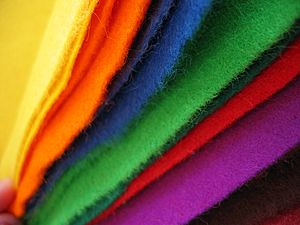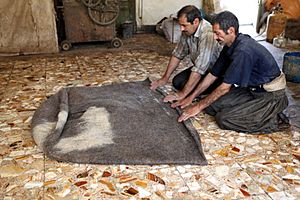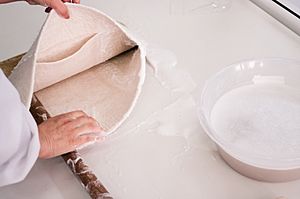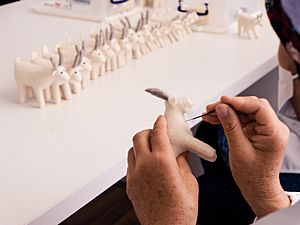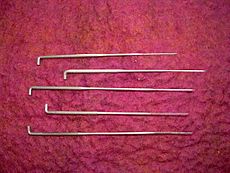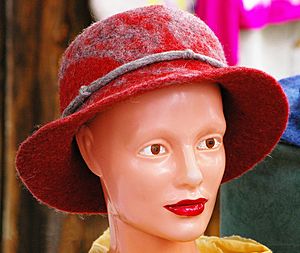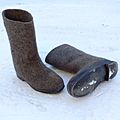Felt facts for kids
Felt is a special kind of cloth. It's made by pressing wool or fur fibers together. This can be done with water and soap, or by poking the fibers with special needles. Felt can be made by hand or with machines.
People have been making felt for a very long time, even longer than other types of fabric. Felt can be any color and made into any shape or size. It's used for many things like clothing, hats, and rugs. Some Nomadic people even live in tents made of felt! Today, felt is also used for making things warm (insulating), blocking sound (sound-proofing), and for soft padding (cushioning).
Contents
How is Felt Different from Other Fabrics?
The main difference between felt and most other fabrics, like denim, is how they are made. Most fabrics are made by weaving threads together in a criss-cross pattern. This makes them strong and smooth. To make woven fabrics, fibers are straightened, spun into long threads, and then woven.
Felt, however, is made differently. Its fibers are just tangled and matted together. This means felt doesn't need to be spun into threads or woven. It only needs a special comb to prepare the fibers. Because it's simpler to make, felt was often used by people who traveled a lot, like nomads.
How is Felt Made?
There are a few ways to make felt. The two main methods are wet felting and needle felting.
Wet Felting: Using Water and Pressure
In wet felting, you use hot water on layers of animal hairs. Then, you repeatedly press and rub the fibers. This makes the fibers hook together and tangle into one solid piece of fabric. Wrapping the fibers in a bumpy material, like a bamboo mat, can help speed up the process.
Needle Felting: Using Special Needles
Needle felting is a way to make felt without water. Instead, it uses special needles. These needles have small hooks or notches along their sides. When you poke the fibers with these needles, the hooks catch the fibers and tangle them together. Needle felting is used in factories and by artists for crafts.
Carroting: An Old Way to Make Hat Felt
An old method called "carroting" was used from the 1600s to the mid-1900s to make good quality felt for men's hats. This process involved treating animal furs (like beaver or rabbit) with a special solution. The fur would turn orange, like a carrot, after being dried. This method helped the fur fibers mat together better. However, the chemicals used were harmful to the hat makers, leading to health problems. This might be where the saying "mad as a hatter" comes from, which was used in the book Alice in Wonderland.
What is Felt Used For?
Felt is used in many different areas, from cars to musical instruments and even in art!
Felt in Musical Instruments
Many musical instruments use felt. It often acts like a soft cushion or a damper.
- On drum cymbal stands, felt protects the cymbal from breaking and helps it make a clear sound.
- It's used to cover bass drum beaters and timpani mallets.
- Pianos use a lot of felt. The hammers that hit the strings are made of wool felt around a wooden center. The softness and springiness of the felt greatly affect how a piano sounds.
- Felt is also placed under piano keys on accordions to make them quieter and control how they feel when pressed.
Felt in Industry
In factories and machines, felt is often used to reduce sound or vibrations. It also provides cushioning and padding for moving parts.
Felt in Arts and Crafts
Felt is used when framing paintings. A piece of felt is placed between the frame and the painting. This protects the painting's edges from getting scratched or damaged.
Felt boards are popular for storytelling with young children. Small felt shapes of animals or people stick to the felt board. The storyteller can move them around as they tell the story. Puppets can also be made from felt. Felt dolls, like the famous Lenci dolls, were very popular in the past.
Felt in Fashion
In the 18th and 19th centuries, gentlemen often wore top hats made from beaver felt. In the early 1900s, many men wore felt hats like fedoras, trilbies, and homburgs. Felt is also used inside boots as liners, like in the traditional Russian valenki boots.
Fun Facts About Felt
- Felt was first made in places like Siberia and Mongolia.
- Nomadic people often used felt for blankets placed under horse saddles.
- An old Sumerian story says that the secret of making felt was found by a person named Urnamman from Lagash.
- A story about Saint Clement and Saint Christopher says they put wool in their sandals to stop blisters while running away from danger. By the end of their journey, the wool had turned into felt socks because of the movement and sweat!
Images for kids
See also
 In Spanish: Fieltro para niños
In Spanish: Fieltro para niños


